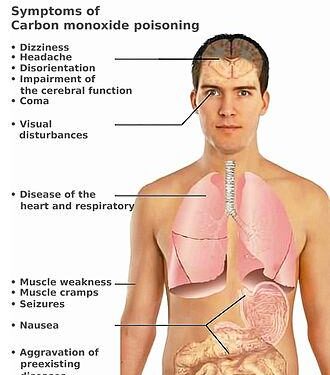Unraveling the Effects of Carbon Monoxide Poisoning on Pediatric Brain Networks Through Graph Theory
A recent pioneering investigation featured in the Wiley Online Library has employed graph theory to explore the complex neural connectivity disruptions in children exposed to carbon monoxide poisoning. Utilizing resting-state functional MRI (fMRI), this study reveals subtle yet critical changes in brain network organization that occur after exposure to this hazardous gas. Given that carbon monoxide remains a significant threat—especially for developing children—these insights not only illuminate long-term neurological consequences but also open avenues for enhanced diagnostic tools and targeted therapies. By integrating advanced statistical frameworks, researchers demonstrate how graph theoretical models can revolutionize neuroimaging interpretations, potentially transforming pediatric toxicology care.
How Carbon Monoxide Exposure Alters Brain Connectivity in Children
The neurological repercussions of carbon monoxide (CO) poisoning are increasingly recognized as profound and enduring, particularly among children whose brains are still maturing. Cutting-edge research employing resting-state fMRI combined with graph theory methodologies has uncovered notable disturbances within both localized and widespread brain networks following CO exposure. These findings emphasize that children’s brains exhibit heightened susceptibility due to ongoing neurodevelopmental processes and elevated metabolic demands.
Key alterations identified include:
- Reduced network efficiency: Impairments were observed in circuits responsible for executive functions such as problem-solving and attention control.
- Disrupted modular organization: The typical clustering of brain regions into specialized functional communities showed significant reorganization.
- Increased regional isolation: Certain critical areas became less integrated within overall brain communication pathways, potentially impeding information flow.
The implications are clear: early recognition is vital since these connectivity disruptions may underlie cognitive delays or behavioral difficulties seen post-poisoning. Further investigations are essential to decode the biological mechanisms driving these changes and to formulate effective rehabilitation protocols tailored for pediatric patients.
The Role of Graph Theory Metrics in Decoding Functional MRI Data Post-Poisoning
The innovative application of graph theory offers a powerful framework for interpreting resting-state fMRI data by modeling the brain as an interconnected network where nodes represent distinct regions and edges symbolize synchronous activity patterns. This approach uncovers intricate connectivity patterns often missed by conventional analyses, highlighting vulnerable hubs and subnetworks affected by hypoxia induced from carbon monoxide exposure.
This study utilized topological measures such as the clustering coefficient, which reflects local interconnectedness among neighboring nodes, alongside the characteristic path length, indicating average communication efficiency across networks. Results revealed statistically significant deviations between children exposed to CO poisoning versus healthy controls:
| Network Metric | Affected Children (Mean ± SD) | Control Group (Mean ± SD) |
|---|---|---|
| Clustering Coefficient | 0.38 ± 0.05 | 0.45 ± 0.04 |
| Characteristic Path Length | 2.75 ± 0 .12 | 2 .33 ± 0 .10 | < /tr >
| Global Efficiency | 0 .48 ± 0 .06 < td >0 .55 ± 0 .05 < /tr > < /tbody > < /table > The diminished clustering coefficient suggests weakened local processing capabilities while increased path length points toward reduced global integration efficiency within neural circuits post-exposure—both factors correlating with clinical symptoms severity observed during follow-up assessments. Tailored Rehabilitation Approaches: Supporting Recovery After Carbon Monoxide Poisoning in Youths
An integrative strategy emphasizing early intervention is crucial for optimizing recovery trajectories among young individuals impacted by carbon monoxide toxicity.
Additionally, continuous monitoring through advanced imaging modalities like fMRI can guide dynamic adjustments throughout rehabilitation phases ensuring interventions remain aligned with evolving neurological status.
n n n nn A Vision Forward: Enhancing Pediatric Outcomes Through Advanced Neuroimaging Insightsnnn This landmark research underscores how leveraging graph theoretical analysis on resting-state fMRI data deepens our understanding of how carbon monoxide poisoning disrupts children’s neural architecture.nBy revealing specific alterations within functional networks linked closely with clinical manifestations,nthe study advocates strongly for preventive vigilance coupled with prompt rehabilitative efforts.nAs awareness heightens regarding this silent hazard,nit becomes imperative that healthcare professionals remain alert,nand public health initiatives intensify education around detection,ntreatment options ensuring affected youth receive timely comprehensive care optimized towards improved long-term outcomes.nnTogether,nthesescientific advancements chart a promising course toward mitigating lasting damage from toxic exposures through precision medicine approaches centered on individual neural profiles.n nn “ |






![[China Tech] Shanghai Chest Hospital Leads Lung Cancer Research Projects – citynewsservice.cn](https://capital-cities.info/wp-content/uploads/2025/11/197172-china-tech-shanghai-chest-hospital-leads-lung-cancer-research-projects-citynewsservice-cn-360x180.jpg)




![[China Tech] Shanghai Chest Hospital Leads Lung Cancer Research Projects – citynewsservice.cn](https://capital-cities.info/wp-content/uploads/2025/11/197172-china-tech-shanghai-chest-hospital-leads-lung-cancer-research-projects-citynewsservice-cn-120x86.jpg)


Marco Rubio Praises India’s Rapid Response to Delhi Red Fort Blast, Emphasizes Self-Sufficiency